Eumorpha satellitia satellitia
|
|
Updated as per CATE Sphingidae (Texas, Mexico, Belize, Costa Rica, Jamaica, Venezuela, Ecuador, Peru, Brazil); April 28, 2011
Updated as per personal communication with Pia Oberg (Urruca Lodge, Jorupe NP, Loja, Ecuador, February 17, 2011); December 1, 2011
Updated as per personal communication with Vadim Kroutov (correction to id of moth from Belize); June 10, 2014
Updated as per personal communication with Tony James (Radisson, Panama, Panama, 122mm, April 19, 2015); May 6 2015
|
Eumorpha satellitia satellitia
you-MOR-fuhMsat-el-LYTE-ee-uh
(Linnaeus, 1771)
Sphinx
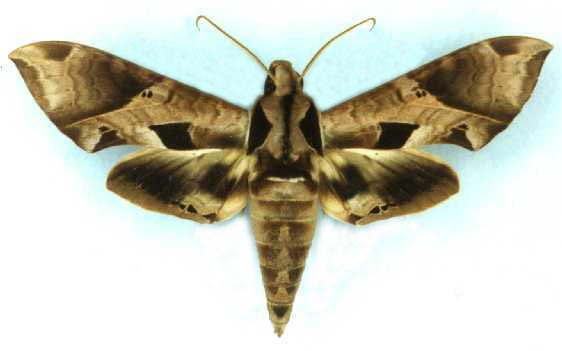
Eumorpha satellitia satellitia male, Jamaica, courtesy of Vernon A. Brou.
This site has been created by Bill Oehlke.
Comments, suggestions and/or additional information are welcomed by Bill.
| TAXONOMY:
Superfamily: Sphingoidea, Dyar, 1902
Family: Sphingidae, Latreille, 1802
Subfamily: Macroglossinae, Harris, 1839
Tribe: Philampelini, Burmeister
Genus: Eumorpha, Hubner, [1807]
Species: satellitia satellitia, (Linnaeus, 1771) |
DISTRIBUTION:
The Satellite Sphinx Moth, Eumorpha
satellitia satellitia (wingspan 114-134 mm,
females larger than males), flies in
Jamaica.
Subspecies Eumorpha satellitia licaon has a much wider distribution in
Mexico;
Belize: Cayo;
Guatemala: Izabal (JM);
to
Venezuela: Monagas (MG);
Ecuador: Loja (PO);
Peru;
further south into Bolivia;
Brazil (not nominate satellitia): Rio de Janeiro: Petropolis; and
Uruguay.
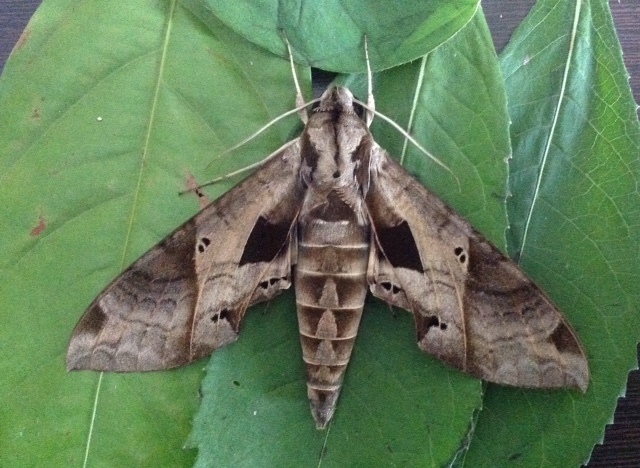
Eumorpha satellitia licaon, Radisson, Panama, Panama,
April 19, 2014, courtesy of Tony James.
Mike Quinn provides this larval image
from extreme southern Texas.
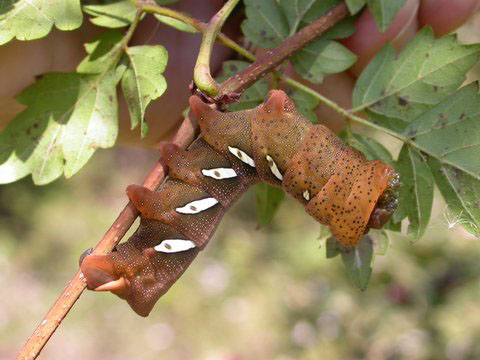
Eumorpha satellitia licaon, October 24, 2005,
Hidalgo County, Texas, courtesy of Mike Quinn.
Subspecies posticatus flies in Cuba: Guantanamo; and the Bahamas; subspecies
excessus flies in Brazil. I am not sure of the range allocations for
the nominate subspecies (limited to Jamaica) and subspecies licaon: Ecuador: Imbabura: Paramba; French Guiana: Kaw.
CATE: "A conspicuous spot behind the eye. Tegulae with large, brown, lateral patches. Abdomen upperside with a series of indistinct patches along
the midline, each tapering anteriorly, not forming a single distinct line (as in Eumorpha satellitia posticatus).
"Forewing upperside largely brown, dusted with paler scales, the pattern not as vivid as Eumorpha satellitia posticatus; posterior margin medially with a
distinct, dark brown rhombiform patch (rather than triangular as in Eumorpha satellitia posticatus), the area between it and the wing base slightly darker
than the ground colour; a further, triangular dark patch on the posterior margin at the tornus; a less distinct subapical triangular patch on the costa;
a double black discal spot present; CuA1 conspicuously paler than the ground colour.
"Hindwing upperside basally buff, inner margin same colour (not pink as in Eumorpha analis and Eumorpha satellitia posticatus); a series of dark
brown or black submarginal black spots near the tornus between CuA1 and 1A, but not continued towards costa as a distinct line
(as in Eumorpha satellitia posticatus), so that inner edge of marginal band is diffuse.
"Male: A pinkish tone all over."
For Eumorpha satellitia licaon CATE indicates, "Somewhat variable in ground colour but generally greyer than Eumorpha satellitia satellitia
and never as green as Eumorpha pandorus. Hindwing upperside inner margin marked with a few red scales."
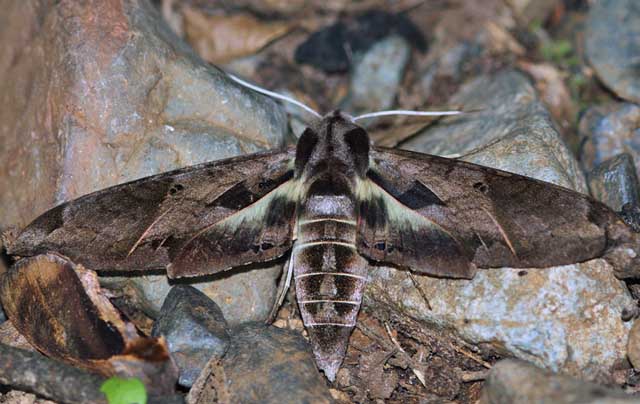
Eumorpha satellitia licaon, Urruca Lodge, Jorupe National Park, Loja, Ecuador,
February 17, 2011, courtesy of Pia Oberg.
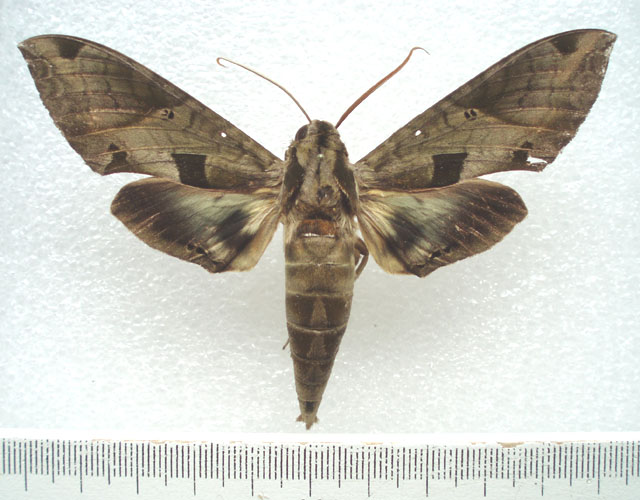
Eumorpha satellitia licaon, Pook's Hill Reserve, Cayo District, Belize,
June 23, 2006, courtesy of Brant Reif, id by Vadim Kroutov.
I originally identified the specimen from Pook's Hill Reserve as
E. triangulum, but most recent information (truncated, dark trapezoidal patch near fw apex) I have obtained (October 19, 2008) from Dan Janzen's website,
and commentary from Vadim Kroutov confirms it is E. satellitia.
In E. triangulaum there is almost always a thick, dark, comma-shaped tail extending from base of the trapezoidal patch
into, at least, the next intraneural section of wing.
FLIGHT TIMES AND PREFERED FOOD PLANTS:
Eumorpha satellitia satellitia adults are on the wing from April to August
and then again in October. Pia Oberg reports a licaon February flight in Loja Province, Ecuador.
Mauricio Gomes reports a licaon December flight in Rio de Janeiro, Brazil.
Eumorpha satellitia satellitia larvae feed upon Cissus pseudosicyoides and Cissus rhombifolia.
Adults feed from flowers including petunia (Petunia hybrida), bouncing bet (Saponaria officinalis), and white campion (Lychnis alba).
ECLOSION, SCENTING AND MATING:
Pupae wiggle to surface just prior to eclosion. Females call at night,
and males (below) fly into the wind to pick up and track the pheromone plume. Eumorpha satellitia licaon
in typical restiong pose. Image courtesy of James Adams. | 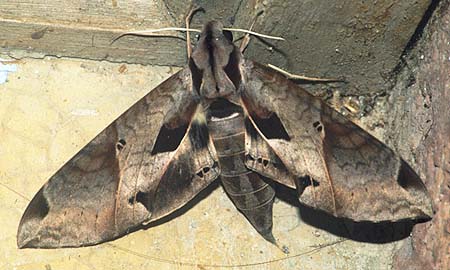 |
EGGS, LARVAE AND PUPAE:
Females lay translucent green eggs singly on leaves of the
host plant. This egg is about to hatch. The anal "horn" is visible through the shell. This image and the following
images (courtesy of Dan Janzen) represent specimens from Costa Rica, and shouild be subspecies licaon. |
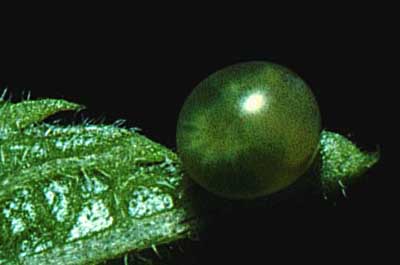 |
Larvae get quite large and consume copious amounts of foliage. Missing leaves and droppings on
the ground, are quick clues that one of the Eumorpha species is on a vine. Parasites take a high toll.
| 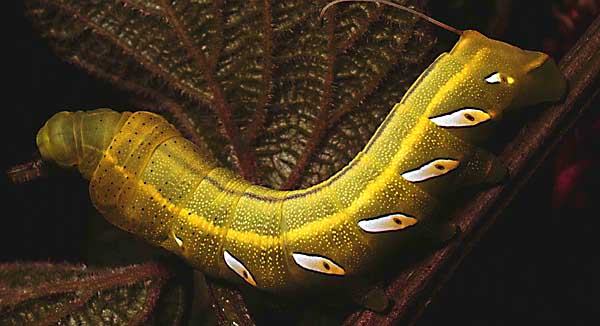 |
When disturbed, the larva quickly retracts the head and thorax. White stripes are elongate and smooth, not
irregular as in achemon or more circular as in pandorus. |
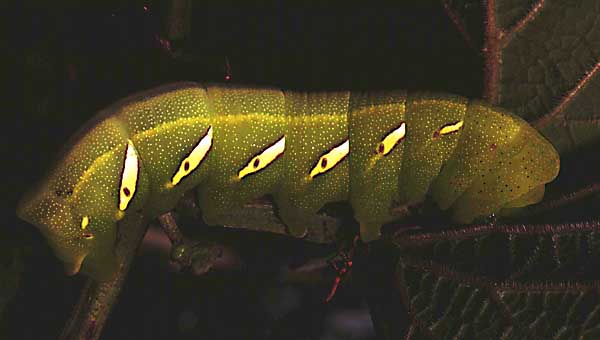 |
Pupation is underground and pupal stage usually lasts five-six weeks before eclosion. The
pupa is long and slender with a long cremaster. |
 |
Larval Food Plants
Listed below are primary food plant(s) and alternate food plants. It is hoped that this alphabetical listing followed by the common name of the
foodplant will prove useful. The list is not exhaustive. Experimenting with closely related foodplants is worthwhile.
Cissus pseudosicyoides.......
Cissus rhombifolia....... | Treebine
Grape and Oak Leaf Ivy
|
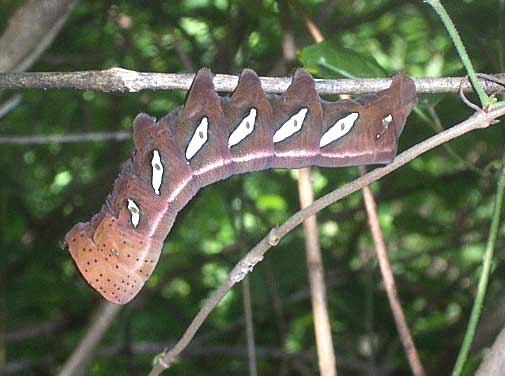
Eumorpha satellitia licaon, Jalpan, Queretaro, Mexico, July 21, 2007, courtesy
of Jim Conrad.
Return to U. S. A. Table
Return to Philampelini Index
Return to Sphingidae Index
Use your browser "Back" button to return to the previous page.
This page is brought to you by Bill Oehlke and the
WLSS. Pages are on space rented from Bizland. If you would like to become a "Patron of the Sphingidae Site", contact Bill.
Please send sightings/images to Bill. I will do my best to respond to requests for identification help.
Enjoy one of nature's wonderments: Live
Saturniidae (Giant Silkmoth) cocoons.
 | 
Show appreciation for this site by clicking on flashing butterfly to the left.
The link will take you to a page with links to many insect sites. |












